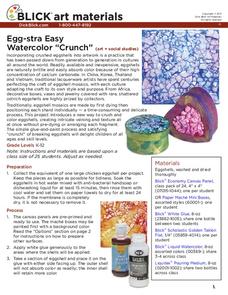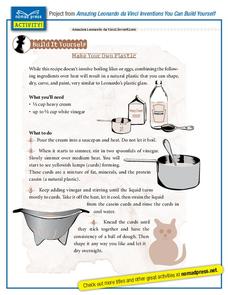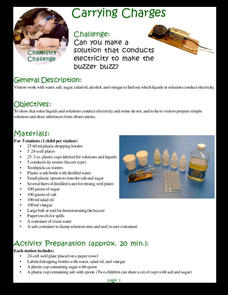Curated OER
Home Living / Daily Living: Nail Care
Nails can get really dirty really fast. Prepare your special education class for life on their own by introducing them to a regular nail care routine. They discuss why it is important to care for your nails and practice washing,...
Curated OER
"Impressionism Painting"
Help your class build visual literacy and artistic ability by having them create a unique impressionistic painting. They'll review impressionistic techniques, and then they'll set to work with paints and collage as they express...
PBS
Blow the Roof Off!
Blow the minds of young scientists with this collection of inquiry-based investigations. Based on a series of eight videos, these "hands-on, minds-on" science lessons engage young learners in exploring a wide range of topics from making...
Dick Blick Art Materials
Egg-Stra Easy Watercolor “Crunch”
It doesn't have to be Easter to enjoy this egg-stra fun art project. Kids crunch egg shells, saturate them with color, and glue them to boxes or other objects to make egg-stra special gifts.
Dick Blick Art Materials
Mehndi Art Gloves
Class members get a chance to practice the art of Mehndi as they use markets to apply patterns to a latex glove.
Curated OER
Oxidation: Does Iron Burn?
Searching for a fairly easy demonstration of how oxidation triggers rust formation? The demonstration allows high school chemists to witness the rusting of metals, as large and small objects are held into a flame while triggering the...
It's About Time
The Nitrogen and Phosphorous Cycles
How do we affect the ecosystem, and what can we do to preserve it? Pupils explore chemicals that promote and inhibit plant growth, then discuss the importance of nitrogen and phosphorus to the survival of organisms and describe how...
Houghton Mifflin Harcourt
Frog Dissection
Guide your learners through the process of opening up a frog. The resource provides step-by-step instructions for dissecting a frog, as well as guiding questions to answer throughout the lab.
Cooking Matters
Breakfast Boost
A healthy and balanced breakfast is essential to maintaining a day's worth of solid energy and mind-power. Encourage class members to eat a smart breakfast with a worksheet that provides interesting food facts, a questionnaire looking...
LABScI
Cell Diffusion and Permeability: The See-Thru Egg Lab
Create a model to study a microscopic phenomenon. The seventh of 12 lessons uses an egg (without its shell) to represent a cell membrane. Using different solutions, learners explore the concept of cell diffusion. They monitor...
Cornell University
Predicting Chemical Reactions
Prove the Law of Conservation of Mass through a lab investigation. A well-designed lesson asks groups to combine materials and monitor indicators for chemical reactions. Measuring the mass of the reactants and products allows individuals...
Beyond Benign
In a Lather
Time to come clean! Scholars continue preparing the shampoo they created in the previous two lessons. The purpose of this stage is to calculate the perfect amount of additive to make the shampoo lather.
Nomad Press
Amazing Leonardo da Vinci Inventions: Make Your Own Plastic
When you hear Leonardo da Vinci mentioned, chances are that you think of the Mona Lisa, or flying machines—but what about plastic? Learners blend heavy cream and vinegar over heat to replicate da Vinci's early organic plastic recipe.
Nuffield Foundation
Effect of Size on Uptake by Diffusion
Cell size is limited by the surface area to volume ratio, but why is this true? Scholars measure the surface area and volume of cubes before placing them into liquid. After a set amount of time, they measure the uptake by diffusion for...
Harper Collins
Narnia Recipes: Turkish Delight
In The Chronicles of Narnia, Edmund Pevensie is willing to sell his family for Turkish Delight. A simple recipe helps recreate the delicacy mentioned in the story. Children can decide if it is worth selling their own families to get some.
Newspaper Association of America
Cereal Bowl Science and Other Investigations with the Newspaper
What do cereal, fog, and space shuttles have to do with newspapers? A collection of science investigations encourage critical thinking using connections to the various parts of the newspaper. Activities range from building origami seed...
Sciencenter
Carrying Charges
What's all the buzz about electricity? Scholars take part in a scientific activity to test the conductivity of liquids and solutions. They first see if water, salad oil, alcohol, and vinegar cause a buzzer to buzz when electrodes are...
Texas State Energy Conservation Office
Investigation: Is Dilution the Solution?
Systematically diluting a full-strength sample of food coloring is meant to help earth scientists understand concentration in parts per million. While they will enjoy the lab exercise, it might be a challenge to help them relate it to...
Curated OER
How Many Drops of Water Can Fit on a Penny?
Using a simple method, learners explore gravity, cohesion, and adhesion. They perform an experiment in which they determine how many drops of water can fit on a penny. Afterwards, they discuss their results.
Curated OER
Measuring the Effects of Gravistimulation on Plants
Learners conduct an experiment to determine if a plant's response to gravity is affected by different angles of plant orientation.
Curated OER
Comparing Roots After Rotation of Ninety Degrees
Young scholars conduct an experiment and use different measurements of a single root to illustrate the mechanism of plant movement.
Curated OER
Observing Root Response After Rotating Plant Ninety Degrees
Students conduct an experiment to observe the response of maize roots when rotated 90 degrees.
Curated OER
Observing the Growth of a Maize Root
Students conduct an experiment in order to observe the typical downward growth of a maize root. They become familiar with the root's growth patterns to use as a control for comparison in other experiments.
Curated OER
Root Caps and the Effect on Gravity Sensing
Students conduct an experiment to determine how the absence of a root cap affects a plant's ability to sense gravity. They make comparisons between capped and decapped roots.

























